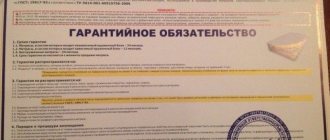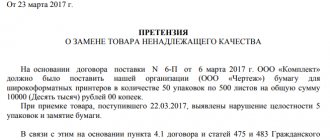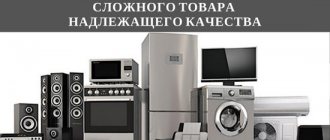10.14.2018 Author:Protection of consumer rights No comments
The text of the Law “On the Protection of Consumer Rights” repeatedly appears the concepts of proper and improper quality of goods, and there are no definitions of these concepts in the text of the Law, as well as in other legislative documents.
From the context of legal requirements, the following definitions for quality can be formulated. Quality is adequate if:
- compliance with all production standards required for such an object is ensured;
- the parameters of its appearance and internal content are met;
- the object is able to satisfy the stated or expected needs of the buyer;
- the product is capable of fulfilling its main purpose as specified in the accompanying documentation.
This means that a product of proper quality is a product that has no defects.
Then the quality will be inadequate:
- not ensuring the fulfillment of its direct functional purpose;
- having deviations from the normal appearance or configuration (contents);
- unable to satisfy the customer's stated or perceived needs;
- different from the characteristics provided for in the accompanying documents;
- having deviations from regulatory documents regulating material, design and production technology.
This means that a product of inadequate quality is a product in which certain shortcomings have been identified.
What are the disadvantages
Disadvantages are divided into:
1. A common drawback is a deviation in the characteristics of an object:
- from the legally established requirements for it;
- from the terms of the contract or standard requirements;
- from the intended functional purpose;
- from the buyer’s requirements, formulated by him descriptively or in the form of a sample.
2. A significant drawback is the deviation of the object’s characteristics:
- which cannot be eliminated due to a design defect;
- to eliminate which it is necessary to spend a disproportionately large amount of money and/or time;
- detected many times after its next elimination.
Depending on the possibility of diagnosing, the disadvantages are:
- Explicit - can be identified during a visual inspection of the object of the transaction and/or its test testing in a store or other trade enterprise.
- Hidden - not detected during visual inspection and in test mode, they manifest themselves during operation during the warranty period, require expert examination or special skill in use.
The following types of shortcomings are distinguished:
- Constructive - a deviation in the quality characteristics of an object caused by a design flaw at the stage of designing and modeling a prototype, before launching it into production. May be the result of unsatisfactory testing or incorrectly selected test parameters that do not correspond to actual operating conditions.
- Production - deviation of product indicators caused by non-compliance with the requirements of design documentation for the manufacture of parts, assemblies and products as a whole during its production. Is the result of unsatisfactory quality control at key stages of assembly and acceptance of finished products.
- Technological – expressed in a deviation in the chemical properties of materials and/or products resulting from a deviation in the parameters of the production process or a deviation in the quality characteristics of raw materials, reagents, etc. The reason may be subjective (inattentiveness of personnel) or objective (malfunction of equipment) in nature.
- Prescription - is a special case of a technological deficiency, characteristic of food and pharmaceutical products. The reason may be a violation of the chemical composition of raw materials, intermediate products, reagents and auxiliary materials.
- Mixed - is a combination of several of the above disadvantages.
- Informational - is a consequence of insufficient information to the buyer about the properties of the purchase, due to the intent or ignorance of the seller.
Expertise
The examination can be carried out at the initiative of any of the parties; it is usually resorted to in the event of a conflict situation when the manufacturer or seller cannot agree with the end consumer on whose fault the damage to the product was caused.
In this case, the following basic rules apply:
- Regardless of the reasons for applying for an examination, all financial costs for its implementation are the responsibility of the seller of goods of inadequate quality or its manufacturer.
- If the result of the examination indicates that the cause of the breakdown was a violation of the operating rules by the consumer, then he will be obliged to reimburse all financial expenses for its implementation. The buyer also retains the right to appeal this decision in court.
- If the result of the examination, on the contrary, indicates the fault of the manufacturer, seller or other responsible person, then he not only pays the full cost of its implementation, but also pays the buyer a penalty in the form of 1% of the price of the goods for each day of delay in the exchange or return process.
Consumer rights when identifying deficiencies
If the consumer identifies deviations in the characteristics of the purchased product, he has the right:
- receive an object similar to the purchased one (the model and article number must match);
- exchange the purchase for another brand, with recalculation of the purchase price and appropriate compensation to one of the parties;
- agrees to use a product with an identified deviation, subject to a proportionate reduction in cost and payment of the difference (discounted product);
- give the purchase to the seller for free repairs or carry out the repairs yourself, with subsequent compensation for expenses;
- terminate the contractual relationship with the seller and demand a refund in full, and in the amount at the time of satisfaction of the claim.
The consumer can exercise his right in relation to goods of inadequate quality:
- Within 14 days after purchase, during this period goods without defects can also be returned if their exchange is permitted by law.
- During the warranty period, an object with significant defects (see above) must be returned, and repairs and an independent examination will be required to compensate for the damage.
- During the service life exceeding the warranty, but not more than 2 years from the date of the sales transaction, unless a longer warranty period is established, repairs and examination will also be required.
Exchange of goods of good quality
Having purchased and paid for a quality product, the consumer cannot exclude the situation that it later turns out that the product is not suitable for him or that there are no opportunities to use it.
In this case, the consumer can exchange the product for a more suitable one under the conditions provided for in Art. 25 of Law No. 2300-I, observing the established rules:
- The return period for goods is 14 days, not counting the day of purchase;
- the product is non-food;
- the presentation has been preserved and the consumer properties of the product have not been lost;
- the product has not been used by the buyer.
As proof of purchase, it is advisable to have a sales or cash receipt with you when contacting the seller for an exchange of goods. The absence of this does not deprive a citizen of the right to exchange goods, but it will complicate the proof of the fact of purchase in a particular store in the event of a dispute with the seller.
Elimination of defects
If defects requiring repair are identified, the buyer has the right to demand that the entrepreneur eliminate them free of charge. Carrying out repairs has its own characteristics:
- The warranty period of the product is extended while it is under repair; therefore, a clear recording of the date of delivery for repair and acceptance after it is required.
- During repairs, the buyer has the right to demand a replacement product with similar characteristics, if it is not included in the relevant list (replacement is not provided for by law).
- If the duration of the repair exceeded 45 days, the defect can be considered significant and the consumer has the right to terminate relations with the seller and compensate for damage.
- If the total duration of repairs in each year of product operation was a month or more, the defect is considered significant, with all the ensuing consequences (see above).
- When repairing at your own expense, the amount of costs must be compensated in full.
Disadvantages of goods when purchasing remotely
If the purchase was made remotely, through one of the online stores, it is subject to the same requirements as for something purchased in a store. If it is determined that the product is of inadequate quality, it may be returned to the seller for replacement or refund.
To establish the fact of inadequate quality of a product, it is necessary to conduct an examination of the product, which will be required to confirm the presence of a defect that arose before receipt by the consumer.
In case of a design, manufacturing or technological defect, the seller must compensate the cost of the product. If the defect was the result of incorrect handling during transportation, financial responsibility falls on the logistics company.
Determining the proper quality of a product
Art. 469 of the Civil Code of the Russian Federation defines what a good quality product is. From the analysis of this norm it follows that goods of appropriate quality are products that comply with:
- the agreement reached between the parties in the sales contract, or the characteristics specified in the description of the goods;
- mandatory requirements specific to this type of product, unless the parties prematurely agreed on the quality of the product;
- purposes of use that the buyer informed the seller when purchasing the goods.
The Law of the Russian Federation “On the Protection of Consumer Rights” dated 02/07/1992 No. 2300-I (hereinafter referred to as Law No. 2300-I) in its preamble contains a definition of a product defect, which consists of non-compliance with the requirements of the law, contract, standard requirements, or the buyer’s goals announced to the seller , or a description/sample of a seller selling according to the description/sample.
Thus, goods of proper quality are products that meet the listed requirements.
In addition, you can pay attention to the following conclusions of the courts regarding the quality of the goods:
You can find more complete information on the topic in ConsultantPlus. Full and free access to the system for 2 days.
- modification of the goods by the seller, depriving the buyer of the opportunity to legally use the goods in the legal field of the Russian Federation, is recognized as a violation of the quality requirement (appeal ruling of the Omsk Regional Court dated July 19, 2017 in case No. 33-4915/2017);
- The concept of quality includes compliance of goods with the requirements of technical regulations and other standards in force in the Russian Federation and regulating the safety of goods for consumers (appeal ruling of the Supreme Court of the Republic of Bashkortostan dated June 20, 2017 in case No. 33-13035/2017).
Returning goods of inadequate quality
Despite the seller’s claims and reluctance to accept the purchase, when returning goods of inadequate quality it is not mandatory:
- availability of a cash or sales receipt, sufficient testimony;
- there is no requirement to preserve packaging, tags, etc., except in cases where identification information is applied to the packaging;
- return of accompanying documentation (passport, instruction manual).
The quality of a product can be considered inadequate if the information provided by the seller during its sale and in the scope of the accompanying documentation is not enough to reliably determine the sufficiency of its properties to meet the user’s needs. In this case, the presence of a certain feature that is inconvenient for the consumer may cause the quality to be considered inadequate, even in the absence of technical malfunctions.
In its enlarged form, any product that does not satisfy consumer needs for any reason can be recognized as a trade product of inadequate quality. Any unsatisfied but justified requirement of the buyer may cause the product to be returned.
Legal advice. Returning goods of inadequate quality
Refusal of goods of proper quality
If such a product is not available at the seller’s point of sale on the day the consumer requested an exchange, the buyer has the right to refuse to fulfill the contract, while demanding a refund of the money paid. The seller is obliged to return the money within 3 days from the date of return of the goods (Clause 2, Article 25 of Law No. 2300-I).
The above rule does not give a direct right to a refund for the purchase. Initially, the buyer must request an exchange of the product for a similar one. Failure to comply with this procedure excludes the satisfaction of demands for return (appeal ruling of the Sverdlovsk Regional Court dated April 4, 2017 in case No. 33-5620/2017).
The seller’s consent to withdraw from the contract in the absence of goods suitable for exchange is not required (appeal ruling of the Moscow City Court dated July 12, 2017 in case No. 33-26853/2017).
Thus, the law protects the consumer and provides for the possibility of refusing a purchased quality product, but not all goods of good quality can be returned.









